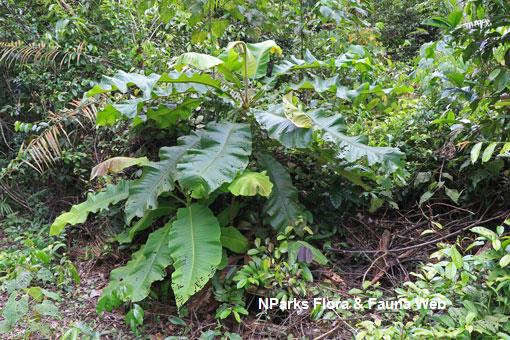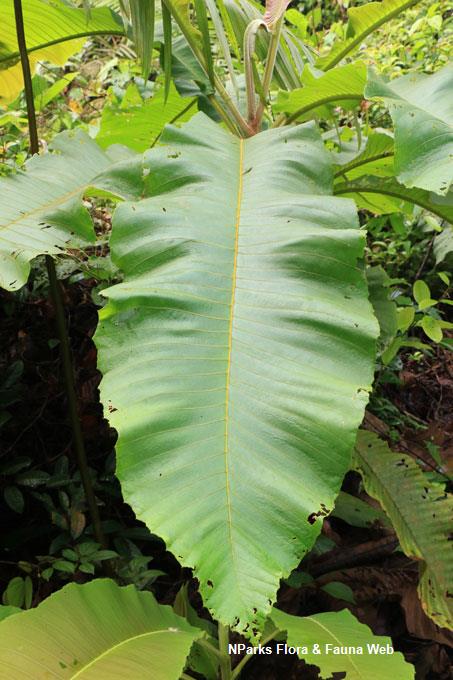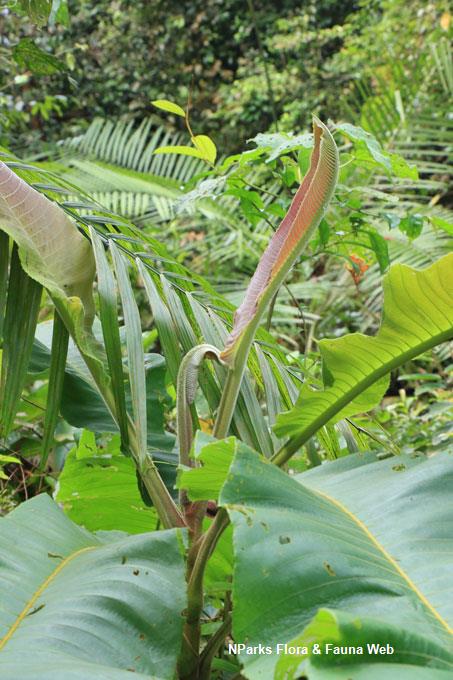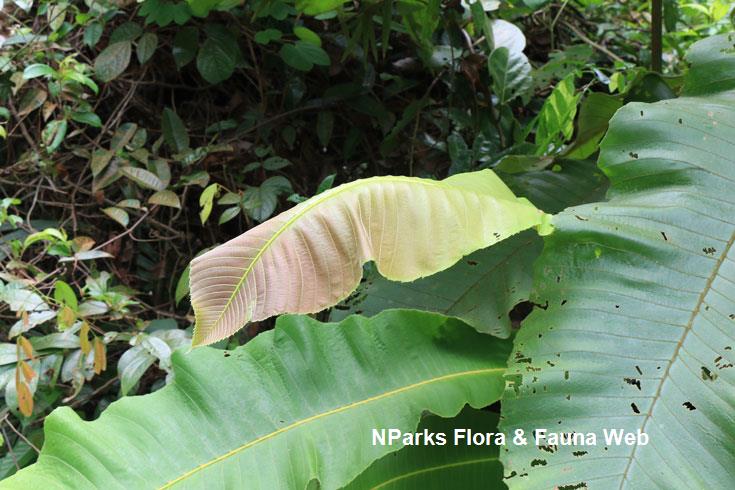
Back
Dillenia reticulata King
| Family Name: | Dilleniaceae |
| Common Name: | Stilted Simpoh, Simpoh Jangkang, Simpoh Gajah |
Dillenia reticulata or Stilted Simpoh is a tall, lofty tree native to Singapore. Reaching to 40 m in height, it produces leaves that grow to 45 cm long. Leaves are covered in velvety golden hairs and when young, the leaves are reddish and turn green with time. Flowers are held in loose clusters of 3 - 15, found at the ends of the branches. The fruit is yellowish-green, measuring 3.5 cm wide, made up of overlapping thick, fleshy calyx.
Name
Classifications and Characteristics
| Plant Division | Angiosperms (Flowering Seed Plants) (Dicotyledon) |
|---|---|
| Plant Growth Form | Tree (Big (>30m)) |
| Lifespan (in Singapore) | Perennial |
| Mode of Nutrition | Autotrophic |
| Plant Shape | Irregular |
| Maximum Height | 40 m |
Biogeography
| Native Distribution | Sumatra, Peninsular Malaysia, Singapore, and Borneo |
|---|---|
| Native Habitat | Terrestrial (Primary Rainforest, Freshwater Swamp Forest) |
| Preferred Climate Zone | Tropical |
| Local Conservation Status | Native to Singapore (Critically Endangered (CR)) |
Description and Ethnobotany
| Growth Form | It is a lofty, deciduous tree that grows to 40m tall, with conspicuous prop roots at the base of the trunk. It has a tall straight trunk with grey-brown or red-brown coloured bark. |
|---|---|
| Foliage | Leaves are elliptic to broadly elliptic or spoon-shaped, possess smooth to finely toothed leaf blades measuring 10-45 by 6-28cm, with venation that resembles a close network. The leaves either have a heart-shaped, narrowed or rounded base. The underside is velvety with golden hairs, veins and midrib are raised below. The leaves are held on a slightly winged petiole about 4-10 cm long. Young leaves are reddish which eventually turn green with time. |
| Flowers | Flowers are held on an loose cluster of 3 - 15 flowers produced at the ends of leafless twigs or twigs with new leaves. The flower consist of 5 yellow petals and sepals, about 8.1 cm wide, densely covered in short hairs. |
| Fruit | The fruit is round, greenish yellow measuring 3.5 cm wide, made up of overlapping, thick, fleshy calyx. Seeds are oval, glossy black measuring 3.5 by 2.5mm with a small aril up to 0.2mm long. |
| Habitat | Occurs in forest and swampy areas at low altitudes up to 200 m tall. |
| Associated Fauna | Its flowers are insect-pollinated. The flowers and possibly the fruits, are also eaten by gibbons and monkeys. |
| Cultivation | It can be propagated by seed. |
| Etymology | Latin Dillenia, commemorating Johann Jacob Dillenius (1687–1747), Professor of Botany at Oxford, author of Historia Muscorum and Hortus Elthamensis; Latin reticulata, conspicuously net-veined, probably referring to the venation of the leaf blades. |
Landscaping Features
| Landscaping | This tree has attractive, large, yellow-petalled flowers. The prop roots at the base of the trunk make this an interesting addition to landscape design. Its tolerance for damp soil makes it suitable for waterlogged sites that most plants do not favour. |
|---|---|
| Desirable Plant Features | Ornamental Flowers, Ornamental Foliage, Ornamental Form |
| Landscape Uses | General, Parks & Gardens, Riverine, Pond / Lake / River, Marsh / Bog |
Fauna, Pollination and Dispersal
| Pollination Method(s) | Biotic (Fauna) (Vertebrates (Other Mammal)) |
|---|---|
| Seed or Spore Dispersal | Biotic (Fauna) |
Plant Care and Propagation
| Light Preference | Full Sun |
|---|---|
| Water Preference | Moderate Water, Lots of Water |
| Plant Growth Rate | Moderate |
| Rootzone Tolerance | Moist Soils, Waterlogged Soils (Drains Site, Does not Drain Site), Fertile Loamy Soils |
| Maintenance Requirements | Moderate |
| Propagation Method | Seed |
Foliar
| Foliage Retention | Evergreen |
|---|---|
| Mature Foliage Colour(s) | Green |
| Prominent Young Flush Colour(s) | Orange, Red |
| Foliar Type | Simple / Unifoliate |
| Foliar Arrangement Along Stem | Spiral |
| Foliar Attachment to Stem | Petiolate |
| Foliar Shape(s) | Non-Palm Foliage (Obovate, Elliptical, Oblong) |
| Foliar Venation | Pinnate / Net |
| Foliar Margin | Entire, Entire - Wavy / Undulate, Dentate |
| Foliar Apex - Tip | Rounded |
| Foliar Base | Cordate, Rounded / Obtuse |
| Leaf Area Index (LAI) for Green Plot Ratio | 3.0 (Tree - Intermediate Canopy) |
Non - Foliar and Storage
| Stem Type & Modification | Woody |
|---|
Floral (Angiosperm)
| Flower & Plant Sexuality | Bisexual Flowers , Bisexual Flowers |
| Flower Colour(s) | Yellow / Golden |
|---|
| Flower Grouping | Cluster / Inflorescence |
| Flower Location | Terminal |
| Flower Symmetry | Radial |
| Flowering Habit | Polycarpic |
Fruit, Seed and Spore
| Mature Fruit Colour(s) | Green, Yellow / Golden |
|---|---|
| Fruit Classification | Aggregate Fruit (Syncarp) |
| Fruit Type | Fleshy Fruit , Accessory / False Fruit (Pseudocarp) |
| Mature Seed Colour(s) | Black |
| Mature Seed Texture(s) | Glossy / Shiny |
References
| References | <1> Hoogland, R.D. (1952). A Revision of the Genus Dillenia. Blumea 7(1):78-80. Leiden: Rijksherbarium. <2> Kochummen, K.M. (1972). Dilleniaceae. Tree Flora of Malaya, vol 1, pp. 191. Kuala Lumpur: Forest Research Institute, Kepong. |
|---|
Image Repository
Others
| Master ID | 1553 |
|---|---|
| Species ID | 2846 |
| Flora Disclaimer | The information in this website has been compiled from reliable sources, such as reference works on medicinal plants. It is not a substitute for medical advice or treatment and NParks does not purport to provide any medical advice. Readers should always consult his/her physician before using or consuming a plant for medicinal purposes. |











